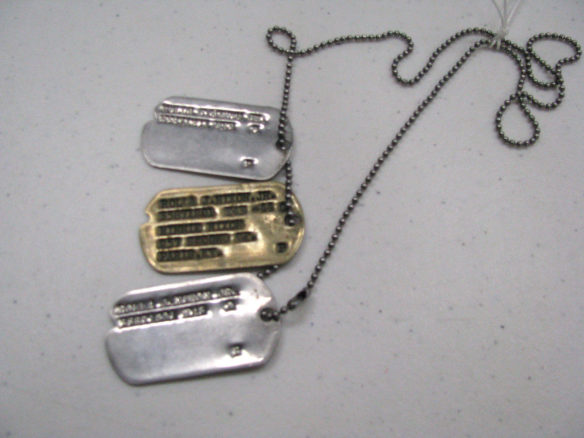
Small local museums can help provide schools with interactive lessons and primary resources from their collections, such as these dog tags in the collection of the Hopewell Museum in Paris.
Photo submitted
Since the COVID-19 pandemic began, museums have been working to adapt to a more virtual world in order to continue engaging with teachers and students.
Many teachers probably are familiar with the virtual offerings from larger state and national museums. Places such as the Smithsonian museums and the National Archives provide a lot of resources that help teachers and students understand major historical events, movements and people. Smaller local museums such as the Hopewell Museum in Paris, however, also have been working these past several months to adapt to the changes brought by COVID-19 and to meet schools’ new standards and goals for historical learning.
Primary Source Packets
Local history museums often can provide more resources than teachers and students may realize. Staff at small archives or museums are often more than happy to provide digital copies of primary sources to teachers that will supplement their lesson.
At the Hopewell Museum, we created digital resource packets featuring primary sources from our collections around a broader topic that connect to the Kentucky Academic Standards (KAS) for Social Studies, with topics such as communications and rationing documents from World War II, Clay family letters and photographs showing daily life in the past. Each packet has a worksheet for students so teachers can use it as a lesson activity or simply use the sources in their existing lesson.
Even if we do not have something available online, we encourage teachers or students to reach out to us when looking for primary sources to supplement lessons. In non-COVID times we offer in-class visits where we can bring actual primary sources and guide students through an object, photography or document analysis lesson.
Virtual Field Trips
We know most of you are little Zoomed out and there is not much that can replace that in-person, hands-on interaction, but again, this is where your smaller local museum can step in to provide a more personal and hands-on interaction, even from a distance.
At the Hopewell Museum, we have created virtual field trips that still allow students to have a hands-on component even if we cannot be there in-person to guide them through it. The teacher can register for one of three field trips that make connections to the current social studies standards. Each lesson has a hands-on component, such as creating your own Talavera tile or Appalachian quilt design. We provide a set of materials for each student that includes any supplies needed to complete the activity. The teacher then has the option to choose a fully guided virtual lesson where we also take the students through the activity or they can choose to have the students do the activity later and we provide the context and historical background.
Research Assistance
In the KAS for Social Studies, Kentucky studies are embedded across disciplines from kindergarten through high school. Using local history helps students place larger historical events into a context that can make them seem more “real” to them. Incorporating local history into lessons often helps students engage more with a larger national narrative if they can connect it to someone or some place they are more familiar with.
As a supporter of National History Day in Kentucky, the Hopewell Museum provides suggestions for local history topics that fit within the annual theme and are available to help teachers and students through the research and project creation process. For example, for this year’s theme of “Communication in History,” students may be interested in learning about soldiers and families writing to each other during times of war. At the Hopewell Museum, we have various letters and materials from local men who went off to fight during World War II that can help students make connections between their lives and those of local people from a significant moment in history. Even if a student is not creating an National History Day project, we can provide assistance with a variety of history-themed projects.
Collaboration
The Hopewell Museum also can provide collaborative opportunities with schools that go beyond the field trip for teachers who are looking for a deeper level of engagement. As a museum with rotating temporary exhibits, we can create opportunities for local schools to work with us to create a historical exhibit. Classes can select the historical topic, conduct the background research, choose the objects/materials from our permanent collections, write the exhibit labels and design how the exhibit will look under the supervision of museum staff. This process allows students to learn about and work as a historian would in a hands-on manner with a final product to show.
We encourage teachers or students to reach out to us at the Hopewell Museum about any of the above activities or opportunities!
Cheryl Caskey is the executive director at the Hopewell Museum in Paris. Previously she was the National History Day in Kentucky and Kentucky Junior Historical Society coordinator for seven years at the Kentucky Historical Society. She can be reached at info@hopewellmuseum.org or (859) 987-7274.




Leave A Comment